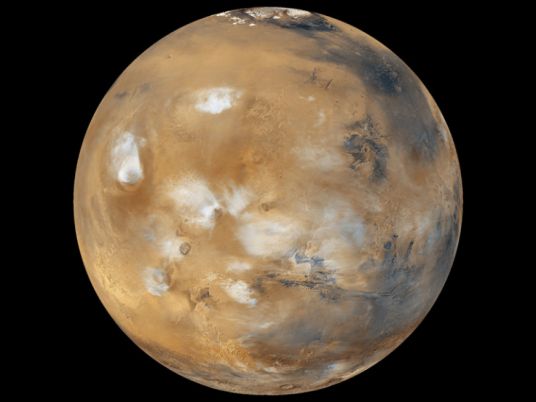
When the first two human colonists land on Mars, they could step into their ready-made living quarters, remove their space helmets and inhale deliciously breathable air.
The quarters would have an optimal mixture of gases for human respiration, and be perfectly pressurized, air-conditioned and thoroughly filtered, if a design paper by a space life-support company becomes reality.
And that air will have been waiting there for two years for the astronauts to arrive. That much time is needed to make sure the Environmental Control and Life Support System, or ECLSS, has a solid track record of working reliably.
The colonists' lives depend on it. Mars' atmosphere is about 95% carbon dioxide and nearly 0% oxygen, a recipe for rapid death.
'In our lifetime'
The vision won't be easily achieved, because space is tricky. To start with, launches, flights and landings often go wrong.
Still, the authors of the preliminary study are confident it can work. "If the will and the means are provided, we will see humans begin to explore and even colonize other planets in our lifetime," said Grant Anderson, president and CEO of Paragon Space Development Corporation.
Paragon designs and manufactures systems that keep astronauts breathing and hydrated in space for NASA and for aerospace corporations. The company is working on the new Orion spacecraft, which will fly astronauts beyond low-Earth orbit and hopefully one day lead to a ship that travels as far as Mars.

Humans colonizing Mars could live in modules with meticulous life support systems.
Paragon wrote the study for Mars One, the Dutch nonprofit company determined to send crews to Mars, never to bring them home to Earth. That would cut out the massive expense of a return trip.
Watching the colonists finish out their lives and eventually die on Mars would make for good entertainment, Mars One believes, and it plans to finance its mission by turning it into a reality TV show.
Robot setup
Even if the meticulously designed systems were to touch down on Mars without a hitch, two robotic rovers would have to schlepp the ECLSS to the colony construction site and set it up. That would require major advancements in the capabilities of Mars rovers, which now move at a sometimes tedious crawl.
Once up and running, the life support system would extract water from rocky strata — or regolith — and purify it for drinking. It would turn some of it into oxygen then mix it with nitrogen and argon gases in Mars' atmosphere to mimic Earth's air.
But those are just the basics in a web of essential tasks the ECLSS would have to perform for years while withstanding Mars' adverse conditions, such as radiation much more intense than on Earth's surface.
Filter, heat, cool
Once it created the breathable atmosphere in the airtight living quarters, it would have to heat and cool it against surface temperatures ranging annually from 220 degrees below zero Fahrenheit (minus 140 Celsius) to 70 degrees Fahrenheit (21 degrees Celsius).
It would pressurize living quarters to Earth-like levels against the lower pressure of Mars' atmosphere outside; filter particles out of the air; expel carbon dioxide and carbon monoxide; and collect exhaled moisture.
It would set a low dew point to prevent condensation, which could cause rust and corrosion of other materials. If there was significant damage to them, they'd have to be replaced via a supply ship all the way from Earth.
Those wouldn't be coming around that often, as colonists would concentrate on eventually living off the land. The water created by the ECLSS would someday be used to irrigate crops and other plants, which would eventually help create breathable air by exchanging carbon dioxide for oxygen.
The ECLSS air system would also have fire detectors and extinguishing systems, and it would automatically replenish the air ruined in a blaze.
While it did all of that, it would have to be very unlikely to break down. If it did, astronauts would have to be able to repair it easily with the limited tools they brought with them or those they could generate via a 3-D printer.
Drink, shower, urinate
When the colonists land, they might also crave a fresh gulp of water on the desert planet, as well as a shower and a bathroom break. The ECLSS would have extracted and stored more than enough water ahead of time.
As colonists splashed about, gargled and did laundry, the system would recycle the used water into drinkable and nondrinkable water.
It would separate out waste not meant for recycling and work to contain microbes and other life forms unavoidably imported from Earth.
Researchers and space travelers have long been keen on protecting Mars from them in order to preserve its original state as much as possible from the side effects of human presence.
More time needed
Though it may sound like they've thought of everything, they haven't, the study's authors say.
"The conceptual design assessment also does not address leak detection, isolation, and repair of crew systems functions such as clothing, personal items, entertainment, galley and food, hygiene, exercise, medical, lighting, fire suppression, or radiation protection," the study says.
It also says nothing about electric power generation or how to mine the water-bearing stone and drag it to the water extraction system.
Engineers will need more time to study it all.
But Mars One is on a rapid track. The first astronaut/reality TV candidates would land in about 12 years from now, if the company has its way.
The idea of starting a colony on Mars so quickly seemed out of this world, so when the company made its public debut two years ago, CNN contacted one of the mission's potential suppliers to check on Mars One's credibility.
"I don't think they deserve to be dismissed," said a spokesman for an aerospace company that contracted for NASA's current Mars mission. He wanted to remain unnamed to avoid spoiling the relationship with Mars One.
The concept is outlandish, he said. But operations like Mars One fund very useful research that may eventually contribute to planting human feet on Martian soil.




